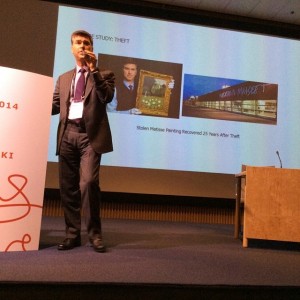Vahinko tulee viisaallekin.
Even the wise one sustains damage.
(Finnish Proverb)
The last sessions of the first day saw two speakers who were were different in appearance and presentation style but who definitely pull together when it comes to bringing back lost art: Christopher A. Marinello, Director and Founder of Art Recovery International and Rune Sivertsen, Detective Superintendent of the Norwegian Police. It was the eloquent lawyer and the straightforward law-enforcer speaking – and we were all spellbound for the next one and a half hours.

Art theft is an „industry“ making 6 billion dollars per year. But how many „good guys“ are there to prosecute these thefts? Marinello had it in figures: In Italy there is one Art Crime Police Officer for 200,000 inhabitants. In the UK it’s one for 15 million inhabitants and in the US it’s one for 20 million inhabitants. Only 15% of lost art is ever recovered. This is one of the reasons why, in Marinello’s opinion, it’s necessary to have help from the private sector.
He introduced the database „Art Claim“ for stolen, looted and missing works of art. One idea is that museums and collectors can register their art works there before anything happens to them. This makes it clear who the original owner is, so art dealers can check the data base when an artwork is presented to them to make sure it isn’t stolen. Police can check the database when they discover an artwork, for example after a razzia.
Another part of the work of Art Recovery International is the negotiation in restitution cases. Chris talked about some difficult cases, including one from the Gurlitt art find. One can only imagine the difficulties of negotiating in cases where something is regarded as legally acquired under the law but still, morally, belongs to the original owner. Convince someone to give a work of art back without compensation just to do the right thing and to right a wrong that happened long ago? Sounds like really hard work.
Now Rune Sivertsen entered the stage for „The Robbery of The Scream and The Madonna from Munchmuseet in 2004“. We were all ears when this police officer revealed the bitter truth of this theft.
There were some circumstances that made it easier for the robbers, although they couldn’t foresee them: The security guard was positioned outside the room where „The Scream“ and „The Madonna“ were on display and the alarm system attached to the pictures was not properly maintained so it didn’t go off when the pictures were removed. The robbers where well prepared for other circumstances: one carried a gun and they used fitting foam glue to silence the alarm bell.

What really shocked us as museum professionals was when the true reason for the theft became apparent: The pictures were not stolen to steal art and sell it. They were only stolen to distract attention and absorb manpower of the police from the investigation of a major monetary robbery at NOKAS (http://en.wikipedia.org/wiki/NOKAS_robbery) conducted by the same organization of criminals! Even more shocking – if possible: The sentences for the robbery were low, the only one who was sentenced to a significant amount of time in jail for this crime was the one who carried a loaded gun…
With the impression that maybe its only we who regard art theft as a „serious“ crime we went off to the Midsummer Party at Kiasma…
This post is also available in French, translated by Marine Martineau.
Too often, the odds are stacked against those protecting the art or those attempting to recover it. So, it’s nice to see when things turn out well for the good guys.
When planned appropriately, the security system helps to deter theft OR for the “undeterred” thief, the system provides the ability to detect them, delay them, defend against them, and forensically support their identification and prosecution. As most of us know, the sooner the thief is detected and identified, the better the chances to recover the art, or even thwart the theft altogether. In terms of security systems, the use of people, effective security procedures, and physical and electronic technology should always be considered in a multi-layered approach.
Unfortunately in many cases, these security systems are lopsided in their application and do not provide the appropriate overlapping or concentric circle approach; which often creates gaps in coverage. The trained thief or even the opportunist looks for these gaps as avenues to steal art.
In most circumstances it’s nearly impossible to understand all motivations for stealing art. It’s even more difficult to know the methods a thief will take to steal art. Therefore, a multi-layered security approach of concentric circles has always been the proven technique to securing art. When planned appropriately; use of detection, delay, and defense concepts will either deter the thief, deny the thief access, or when thief succeeds – provide sufficient forensic techniques to quickly identify the thief and recover the art. When using a multi-layered security approach; a loss of single security system function (i.e., forgetting to turn on a sensor, or not locking an exhibit case) would not render the security system ineffective.